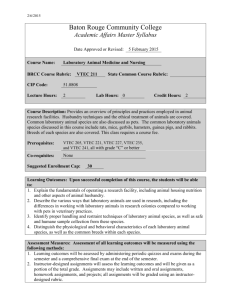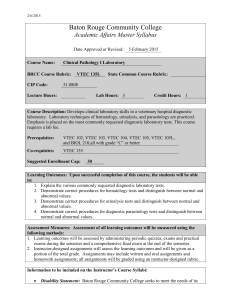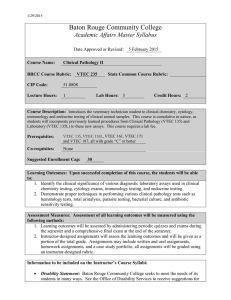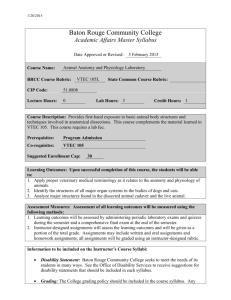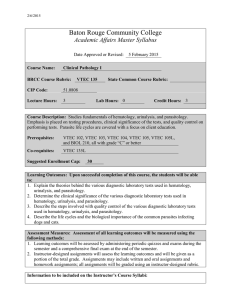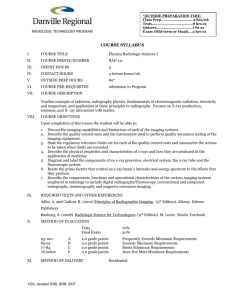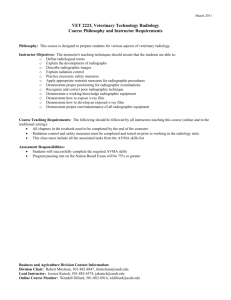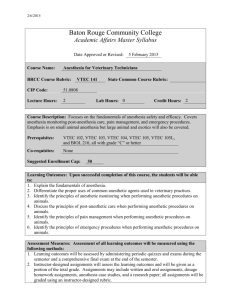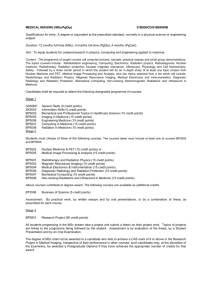VTEC_161_MS - Baton Rouge Community College
advertisement
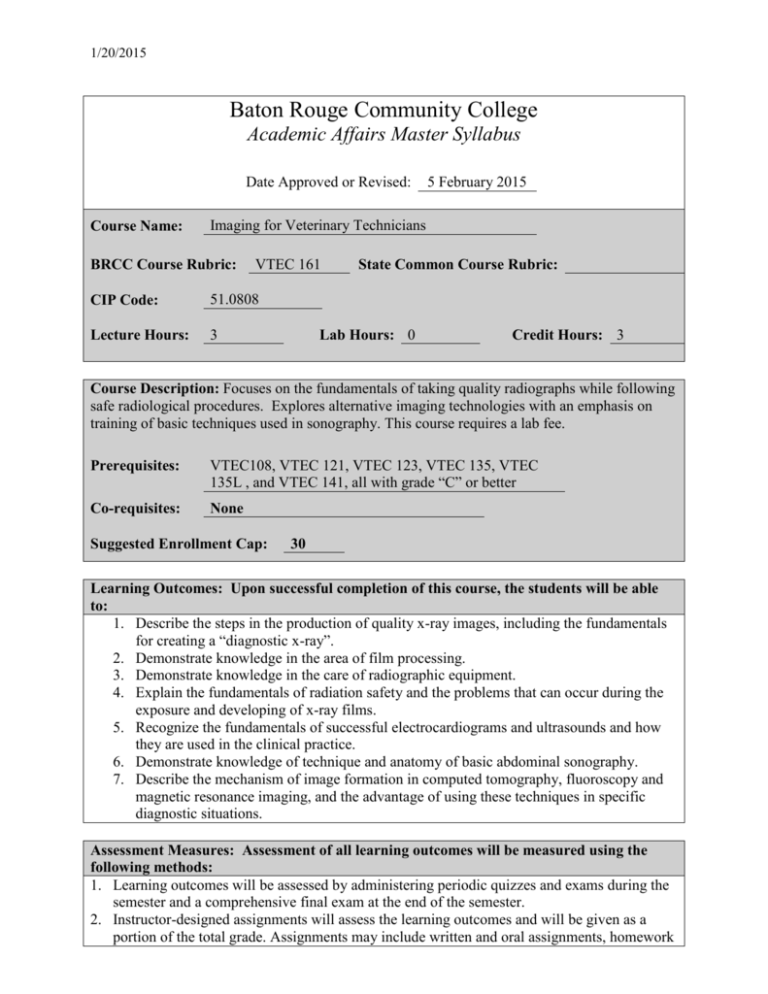
1/20/2015 Baton Rouge Community College Academic Affairs Master Syllabus Date Approved or Revised: Course Name: 5 February 2015 Imaging for Veterinary Technicians BRCC Course Rubric: VTEC 161 CIP Code: 51.0808 Lecture Hours: 3 State Common Course Rubric: Lab Hours: 0 Credit Hours: 3 Course Description: Focuses on the fundamentals of taking quality radiographs while following safe radiological procedures. Explores alternative imaging technologies with an emphasis on training of basic techniques used in sonography. This course requires a lab fee. Prerequisites: VTEC108, VTEC 121, VTEC 123, VTEC 135, VTEC 135L , and VTEC 141, all with grade “C” or better Co-requisites: None Suggested Enrollment Cap: 30 Learning Outcomes: Upon successful completion of this course, the students will be able to: 1. Describe the steps in the production of quality x-ray images, including the fundamentals for creating a “diagnostic x-ray”. 2. Demonstrate knowledge in the area of film processing. 3. Demonstrate knowledge in the care of radiographic equipment. 4. Explain the fundamentals of radiation safety and the problems that can occur during the exposure and developing of x-ray films. 5. Recognize the fundamentals of successful electrocardiograms and ultrasounds and how they are used in the clinical practice. 6. Demonstrate knowledge of technique and anatomy of basic abdominal sonography. 7. Describe the mechanism of image formation in computed tomography, fluoroscopy and magnetic resonance imaging, and the advantage of using these techniques in specific diagnostic situations. Assessment Measures: Assessment of all learning outcomes will be measured using the following methods: 1. Learning outcomes will be assessed by administering periodic quizzes and exams during the semester and a comprehensive final exam at the end of the semester. 2. Instructor-designed assignments will assess the learning outcomes and will be given as a portion of the total grade. Assignments may include written and oral assignments, homework assignments, and a research paper; all assignments will be graded using an instructordesigned rubric.. 3. Assessment of clinical skills will be via student demonstration of required skills, graded using a standardized rubric. Information to be included on the Instructor’s Course Syllabi: Disability Statement: Baton Rouge Community College seeks to meet the needs of its students in many ways. See the Office of Disability Services to receive suggestions for disability statements that should be included in each syllabus. Grading: The College grading policy should be included in the course syllabus. Any special practices should also go here. This should include the instructor’s and/or the department’s policy for make-up work. For example in a speech course, “Speeches not given on due date will receive no grade higher than a sixty” or “Make-up work will not be accepted after the last day of class.” Attendance Policy: Include the overall attendance policy of the college. Instructors may want to add additional information in individual syllabi to meet the needs of their courses. General Policies: Instructors’ policy on the use of things such as beepers and cell phones and/or hand held programmable calculators should be covered in this section. Cheating and Plagiarism: This must be included in all syllabi and should include the penalties for incidents in a given class. Students should have a clear idea of what constitutes cheating in a given course. Safety Concerns: In some programs this may be a major issue. For example, “No student will be allowed in the safety lab without safety glasses.” General statements such as, “Items that may be harmful to one’s self or others should not be brought to class.” Library/ Learning Resources: Since the development of the total person is part of our mission, assignments in the library and/or the Learning Resources Center should be included to assist students in enhancing skills and in using resources. Students should be encouraged to use the library for reading enjoyment as part of lifelong learning. Expanded Course Outline: I. Production of x-rays A. Exposure factors B. Radiographic quality C. Radiographic density (darkness) D. Contrast E. Scatter radiation F. Grids G. Image receptors H. Cassette I. Intensifying screens J. X-ray films 2 II. Developing and preserving of radiographic films A. Darkroom fundamentals, film and cassette preparation B. Manual processing C. Automated processors III. Critiquing radiographs A. “Diagnostic x-rays” B. Radiographic artifacts IV. Radiation safety A. Primary radiation B. Secondary radiation V. Animal anatomy seen on radiographs VI. Specific radiographic techniques A. Extremities B. Thorax C. Abdomen D. Skull E. Deep bones F. Pelvis G. Vertebrae H. Femur VII. Large animal and exotic animal radiology VIII. Developing x-ray technique charts IX. Ultrasonography A. Production of ultrasound image B. Common findings and artifacts C. Care and use of small animal ultrasound for abdominal exam D. Animal anatomy seen on ultrasound X. Other Imaging Systems A. Nuclear Scintigraphy B. Fluoroscopy C. Doppler Echocardiogram D. Computed Tomography E. Magnetic Resonance Imaging XI. Indications for use of alternative imaging 3
